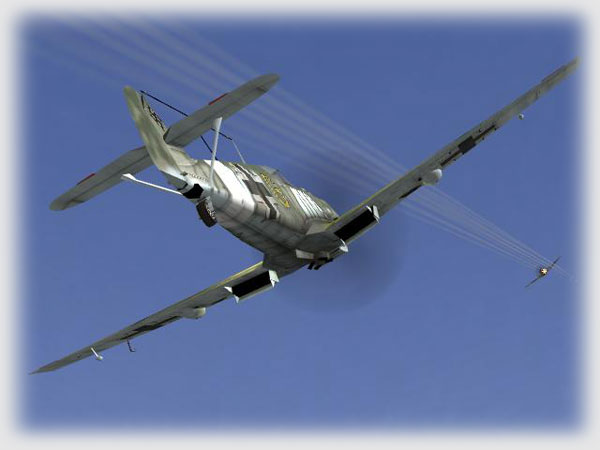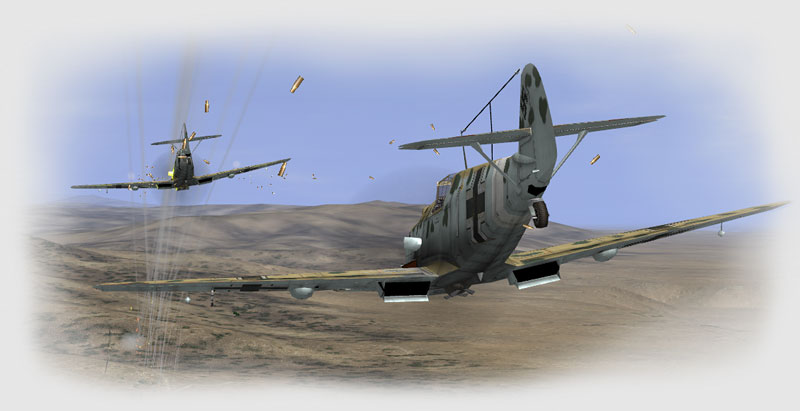Communications
Three key things to remember…
Flight cues are the most frequently used form of communication.
The idea is to telegraph the next move in a subtle fashion. A slight roll to the right before executing a hard right turn, a flash of rudder before rolling into a split-S, a slight nose up before a hard turn works wonders in letting the Wingman know what one is about to do. The truth is that most of us do this naturally, which is on of the reasons why the enemy on our sixes can stay with us. The Wingman has to pay attention to what the Lead is doing as closely as if he were an enemy aircraft as well as scanning the sky for actual enemies.
Sudden, radical maneuvers by the Lead are the number one cause of team breakage.
The Leader must understand that he has a responsibility to allow the Wingman to follow and protect. Think of flying with a short wheelbase trailer hitched to the tail of your plane when acting as Lead.
Radio (TeamSpeak) communications are the best way of talking to a teammate.
We have a huge advantage over the WWII pilots we’re emulating in that our voice communications are always working, are secure from the enemy, and can’t be used for radio location. Talk to your teammate. Say in simple terms what you want to do or are doing. Annunciate and talk clearly! The flight community is global in nature, and accented Northern American or British or Australian English can be hard to understand when placed against a natural Southern Drawl. Our English as a second language community members are fantastic, but one must help them out by keeping things simple and clear.
Brevity Codes
Here are a few brevity codes that are standard to the flight community…
Bingo: Just enough fuel left to return home.
Break: A sharp avoidance maneuver to spoil an enemy’s aim. Best given with a direction (“Break Right!” or “Break Left!”). It supersedes all other commands and can be given by either Leader or Wingman. Always try to get the friendly to break across the nose of the enemy rather than away from it and towards one’s own aircraft — you want to move into position to attack the enemy and break the chase!
Break-break-break: Literally, “shut up, I have something important to say.” Let’s say one is expounding on the virtues of a given HOTAS and rudder setup that is leading up to a segue way into the merits of Ford trucks versus Chevrolet and the tasks at hand require attention. “Break-break-break: ground fire from the left!” or “Break-break-break: Contact right, low, one fighter heading away from us!” It is the responsibility for everyone to shut up when one person says “Break-break-break.”
Contact: Enemy sighted. Given with a direction and relative altitude, either using the clock or side method (if both planes are still going the same way), such as “Contact, ten o’clock low,” or “Contact, front left low!” for those raised with digital watches; by compass heading; or by cardinal direction. It is preferable to give number and type of aircraft as well, as well as any situational information one can figure out. “Contact, ten o’clock low, three fighters heading towards us!” is a good example.
In: Actively attacking.
Winchester: Out of ammunition.
Some less-than-standard but need-to-know brevity codes…
A Bit: As a length of time, longer than two minutes. In distance, between two and four kilometers away and out of direct view.“It will take me a bit to get to you” or “The target is a bit more down this river.”
Egg: A bomb.
Yonder: An object that is beyond immediate range but within viewing distance. “That airfield over yonder to the left is active.”
Well, they are “need to know” if someone is flying with me!
Text is the least efficient way of communicating! When all else fails, type out the message. It’s handy to set a few default chat messages into the quick chat buffer, such as “break right” or “break left” and “No worries, at least it was FRIENDLY fire!” to cut down on the time required to type. In a coop mission, the Leader can use the menu commands as well.
Also see Vince “Beer Camel” Putze’s article on Brevity Codes here.














